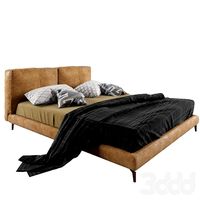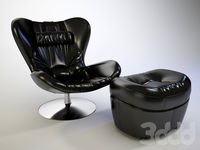Thingiverse

Audiophile Sound Diffusors by bkubicek
by Thingiverse
Last crawled date: 3 years ago
What is a diffusor ?
==
If you have an room with unpleasing audio properties, one possibly reasons can be echos that occur in a structured way. Early echos (e.g. <0.4 sec) are e.g. well known for inhibiting personal speaking comfort.
Now to get rid of echos, there are two practical ways: sound absorbers and sound diffusors.
The goal of a good diffusor is to scatter sound, so that a specific incoming sound goes to all possible output directions. Hence echos are quite "mute" and do not start at a precise time, but one hears a slow buildup and decrease of echo noise.
Audio absorbers create a harsh empty environment, similar to speaking in open air, while diffusors create a "warm" and sound of a well stocked living room.
Mainly, there exist one and two-dimensional variants, and a you will find heaps of information in the references. And, they are extremely common in recording studios.
Where do you want to put your diffusor ?On the sides and above the "viewing direction" to the sound source. In your rear, sound absorbers are a better choice.
Building a diffusor
==
Usually, diffusors are made from wood. The material should be reasonably stiff, so sound does not deform it. Ideally, the material should not burn, which sadly, PLA and ABS do. So, please be aware that a room with diffusors is a possible deathtrap.
I figured that these diffusors can be printed easily with 3d printers, although the printsize requires to join many pieces to obtain a large enough area to actually effect the room sound. For a minimal effect, you want a couple of square meter (>25 prints).
Cost Analysis
I found one offer where 6 pieces of 0.6*0.6 mm diffusor cost 370 E. Thats 170 E per square meter.
If you 3d print it with the octagonal structure, you will need 5kg of filament per square meter. Thats in a similar price regime. If you print for material costs. Also, you need to print for 16 days for a square meter on my printer...
The files
--
All files are created using openscad, the stls are just examples, and its highly recommended that you do not reuse a single part in a panel, but each part should be different. Also, you want to set the wall thickness according to your 3d printers nozzle.
2d rectangular diffusor. It has sideholes, to mount the pieces together. It is suited for 3d printing, but takes quite a while.
Hexagonal diffusor. I figured that instead of a recitlinear grid, the diffusor cells can be aligned in a hexagonal layout. Really neat, no? However, you need to play with your slicing software, so that the outside walls actually print.
Manhatten 1d diffusor, which prints quickest, but only diffuses in one direction. The figer structure might be to small, you might want to increase the cell size to 20mm, for even faster printing.
Reference:
==
The videos linked here are also shown above. They are not from me, and I just wanted to link them for further information for the reader.
http://en.wikipedia.org/wiki/Diffusion_%28acoustics%29
http://www.youtube.com/watch?v=qFeM2uWuMZI
http://www.youtube.com/watch?v=FOjHsexNBTQ
http://arqen.com/sound-diffusers/
http://www.mh-audio.nl/diffusor.asp
==
If you have an room with unpleasing audio properties, one possibly reasons can be echos that occur in a structured way. Early echos (e.g. <0.4 sec) are e.g. well known for inhibiting personal speaking comfort.
Now to get rid of echos, there are two practical ways: sound absorbers and sound diffusors.
The goal of a good diffusor is to scatter sound, so that a specific incoming sound goes to all possible output directions. Hence echos are quite "mute" and do not start at a precise time, but one hears a slow buildup and decrease of echo noise.
Audio absorbers create a harsh empty environment, similar to speaking in open air, while diffusors create a "warm" and sound of a well stocked living room.
Mainly, there exist one and two-dimensional variants, and a you will find heaps of information in the references. And, they are extremely common in recording studios.
Where do you want to put your diffusor ?On the sides and above the "viewing direction" to the sound source. In your rear, sound absorbers are a better choice.
Building a diffusor
==
Usually, diffusors are made from wood. The material should be reasonably stiff, so sound does not deform it. Ideally, the material should not burn, which sadly, PLA and ABS do. So, please be aware that a room with diffusors is a possible deathtrap.
I figured that these diffusors can be printed easily with 3d printers, although the printsize requires to join many pieces to obtain a large enough area to actually effect the room sound. For a minimal effect, you want a couple of square meter (>25 prints).
Cost Analysis
I found one offer where 6 pieces of 0.6*0.6 mm diffusor cost 370 E. Thats 170 E per square meter.
If you 3d print it with the octagonal structure, you will need 5kg of filament per square meter. Thats in a similar price regime. If you print for material costs. Also, you need to print for 16 days for a square meter on my printer...
The files
--
All files are created using openscad, the stls are just examples, and its highly recommended that you do not reuse a single part in a panel, but each part should be different. Also, you want to set the wall thickness according to your 3d printers nozzle.
2d rectangular diffusor. It has sideholes, to mount the pieces together. It is suited for 3d printing, but takes quite a while.
Hexagonal diffusor. I figured that instead of a recitlinear grid, the diffusor cells can be aligned in a hexagonal layout. Really neat, no? However, you need to play with your slicing software, so that the outside walls actually print.
Manhatten 1d diffusor, which prints quickest, but only diffuses in one direction. The figer structure might be to small, you might want to increase the cell size to 20mm, for even faster printing.
Reference:
==
The videos linked here are also shown above. They are not from me, and I just wanted to link them for further information for the reader.
http://en.wikipedia.org/wiki/Diffusion_%28acoustics%29
http://www.youtube.com/watch?v=qFeM2uWuMZI
http://www.youtube.com/watch?v=FOjHsexNBTQ
http://arqen.com/sound-diffusers/
http://www.mh-audio.nl/diffusor.asp
Similar models
thingiverse
free

Amazon Echo Dot acoustic stand reverb by ProtomakerSprint
...see:
lattice structure absorbs vibrations
http://www.scienceandtechnologyresearchnews.com/lattice-structure-absorbs-vibrations/
.
3dwarehouse
free

HOFA Frame For One Module
...gs the installation is quite simple. #absorber #acoustic #acoustics #akustikmodul #diffusor #hifi #hofa_akustik #recording_studio
3dwarehouse
free

HOFA Changing Frame With Absorber And Diffusor
...gs the installation is quite simple. #absorber #acoustic #acoustics #akustikmodul #diffusor #hifi #hofa_akustik #recording_studio
3dwarehouse
free

HOFA Changing Frame With Absorbers
...gs the installation is quite simple. #absorber #acoustic #acoustics #akustikmodul #diffusor #hifi #hofa_akustik #recording_studio
3dwarehouse
free

HOFA Changing Frame With Diffusors
...on is quite simple. #absorber #acoustic #acoustics #akustikmodul #diffusor #hifi #hofa_akustik #recording_studio weniger anzeigen
3dwarehouse
free

Home Theaters & Music Rooms - Acoustical Diffusion - The Curve System
...sor #acoustical_home_theater #acoustical_materials #acoustical_meeting_room #noisy_home_theater #sound_panels #soundproof_theater
3dwarehouse
free

HOFA Changing Frame For Two Modules
...gs the installation is quite simple. #absorber #acoustic #acoustics #akustikmodul #diffusor #hifi #hofa_akustik #recording_studio
3dwarehouse
free

HOFA Absorber
...ic elements for the optimization of the room sound. #absorber #acoustic #acoustic_models #akustik #hofa #recording_studio #studio
3dwarehouse
free

HOFA Absorber ECO
...ic elements for the optimization of the room sound. #absorber #acoustic #acoustic_models #akustik #hofa #recording_studio #studio
3dwarehouse
free

GIK Acoustic Sound Panel Diffusers - Palomar Style
...gn 3 sizes - square, narrow and rectangle https://www.gikacoustics.com/product/impression-2inch-acoustic-panel-diffusor-absorber/
Bkubicek
thingiverse
free

sinus bracelet by bkubicek
...using c++, with a code that was the precessor of http://www.thingiverse.com/thing:35437https://github.com/bkubicek/sphericalator/
thingiverse
free

Calibration body by bkubicek
...calibration body by bkubicek
thingiverse
for finding correct steps per mm in the axis of a 3d printer.
thingiverse
free

Groundwater logger by bkubicek
...groundwater logger by bkubicek
thingiverse
this things logs the groundwater level and centigrade temperature onto a sd card.
thingiverse
free

Repetar XY plated by bkubicek
...repetar xy plated by bkubicek
thingiverse
for faster printing. see remix parent.
thingiverse
free

Knife Rack by bkubicek
...ife rack by bkubicek
thingiverse
fitting into ikea cabinets.
is a little bit too small to fit thightly.
40,33, and 20mm width.
thingiverse
free

pen holder remix by bkubicek
...pen holder remix by bkubicek
thingiverse
less pencils, bigger size, so that pilot pens work.
thingiverse
free

overworked ian fan by bkubicek
...overworked ian fan by bkubicek
thingiverse
this should hopefully have less pressure loss and blow stronger.
thingiverse
free

Bus Pirate v3.5c housing by bkubicek
...bus pirate v3.5c housing by bkubicek
thingiverse
takes advantage of the screw-holes of the pcb.
thingiverse
free

Foot for Ultimakers by bkubicek
... case you mod your ultimaker with a longer z-axis stepper motor, these will help you to still have a reliable standing ultimaker.
thingiverse
free

Ultimaker XY cross aligner by bkubicek
...ultimaker xy cross aligner by bkubicek
thingiverse
for double 8mm rods (very old machines)
Audiophile
turbosquid
$29

Audiophile Film Capacitors
... available on turbo squid, the world's leading provider of digital 3d models for visualization, films, television, and games.
3d_export
$35

Bookshelf Speaker M-Audio Stereophile LX4 3D Model
...speaker m-audio stereophile lx4 3d model 3dexport speaker audio audiophile stereophile electronics music sound bookshelf home-cinema cinema monitor monitors...
3d_export
$7

headphones audeze lcd-2
...contains high-poly 3d models consisting of the following components: -audiophile headphones audeze lcd-2 rooms audio line headphone stands -dimensions...
3d_sky
free

Set audiophile
...set audiophile
3dsky
beats iphone headphones phone smartphone
beats headphones with iphone
thingiverse
free

Odrophile: odroid c0 based audiophil tablet by jit06
...details can be found on my blog post : https://www.bluemind.org/odrophile-odroid-c0-based-audiophiletablet ...
3d_sky
free

Retro set audiophile
...s
decorative set in retro style. cream dock for philips ipod, iphone ord7105c / 10.http://www.philips.ru/cp/ord7105c_10
3dbaza
$2

Audiophile Chandelier (339560)
...lt;br>xform: no<br>box trick: no<br>model parts: 4<br>render: v-ray<br>formats: 3ds max 2014, obj, fbx
thingiverse
free

Hiby R6 Audiophile Android Player Dock Station by eaonmagnus
...giverse
a simple dock station for the hiby r6 audiophile android music player. design to fit with the rubber case on the player.
thingiverse
free

Wood Grain Tool by audiophil
...ture is northeastern board and batten 1/4" siding that has been textured on the left with the tool and is stock on the left.
thingiverse
free

Woodgrain tool for modeling - 7 Xacto Knives by audiophil
...ent through lock holes. the parallel blades create a pattern that simulates woodgrain. credit for the concept to frank markovich.
Diffusors
design_connected
$16

Tolomeo Parete Diffusore
... parete diffusore
designconnected
artemide tolomeo parete diffusore computer generated 3d model. designed by de lucchi, michele.
3ddd
free

Tolomeo Suspension Decentralized SOLO DIFFUSORE ANELLO
... anello
светильник tolomeo suspension decentralized solo diffusore anello из новой коллекции artemide
3d_export
$10

bola disc table
...ology.<br>max 2016,2013<br>fbx+obj<br>https://store.pablodesigns.com/collections/table/products/bola-disc-table
thingiverse
free

WF502B Diffusor by ripper121
...wf502b diffusor by ripper121
thingiverse
wf502b diffusor
thingiverse
free

Flash Diffusor by jerome_k
...flash diffusor by jerome_k
thingiverse
large diffusor for pop-up flash. attenuates the shadow of the lens at wide angle.
thingiverse
free

Diffusor for LED lights by BKTRIE
...diffusor for led lights by bktrie
thingiverse
a diffusor for led stripes .... build with spiral printing
thingiverse
free

Thrunite TN4A Diffusor by TIGRA
...thrunite tn4a diffusor by tigra
thingiverse
diffusor for thrunite tn4a.
works well, but the fit could be a bit strong.
thingiverse
free

Chillum Diffusor by Markusx26
... 9 mm
just a quick project to put down the preasure in the chillum when in use
and to get a better cooling/mixing with the water.
thingiverse
free

Nikon Flash Diffusor by Hac78
...nikon flash diffusor by hac78
thingiverse
remix of a great diffusor to fit my nikon d90.
printed my in natural petg.
thingiverse
free

Dach Diffusor by Suter-3D-Design
...dach diffusor by suter-3d-design
thingiverse
dach diffusor zum selber ausdruckern
Sound
turbosquid
$5

sound
...royalty free 3d model sound for download as max, obj, and fbx on turbosquid: 3d models for games, architecture, videos. (1211937)
3ddd
$1

Sound Bed
...sound bed
3ddd
sound
bed
3ddd
$1

Natuzzi / SOUND
...natuzzi / sound
3ddd
natuzzi
natuzzi модель - sound
turbosquid
$109

Sound Boom
...bosquid
royalty free 3d model sound boom for download as c4d on turbosquid: 3d models for games, architecture, videos. (1568341)
turbosquid
$5

Sound Booster
...quid
royalty free 3d model sound booster for download as stl on turbosquid: 3d models for games, architecture, videos. (1363395)
turbosquid
$3

Sound Card
...bosquid
royalty free 3d model sound card for download as fbx on turbosquid: 3d models for games, architecture, videos. (1709721)
turbosquid
$1

Stereo Sound
...squid
royalty free 3d model stereo sound for download as obj on turbosquid: 3d models for games, architecture, videos. (1342541)
3d_ocean
$5

Sound Heart
... day wing wings
sound heart with wings. setup render and environment map with vray. thank you! please see some of my collection…
turbosquid
$45

Sound Car
...lty free 3d model sound car for download as max, fbx, and obj on turbosquid: 3d models for games, architecture, videos. (1540353)
turbosquid
$25

Speaker Sound
...ee 3d model speaker sound for download as 3ds, obj, and blend on turbosquid: 3d models for games, architecture, videos. (1323810)
